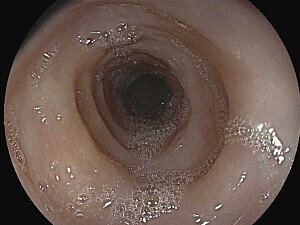The 2020 American Gastroenterological Association and Joint Task Force on Allergy–Immunology guidelines on managing eosinophilic esophagitis (EoE) reclassified what was previously known as “proton pump inhibitor (PPI)–responsive EoE” as a “subtype of EoE with PPI response.” A trial of PPI is no longer a diagnostic criterion, and PPI monotherapy is now considered a treatment option for EoE.
However, few studies have compared the clinical and allergy profiles of patients with PPI-responsive EoE (PPI-r-EoE) or PPI-nonresponsive EoE (PPI-nr-EoE) against those of patients who have erosive esophagitis (EE) that can develop secondary to gastroesophageal reflux disease (GERD).
Walter W. Chan, MD, MPH, director of the Center for Esophageal/Gastrointestinal Disorders at Brigham and Women’s Hospital, Mayssan Muftah, MD, senior GI fellow, and colleagues have reported supporting evidence that PPI-r-EoE is clinically similar to PPI-nr-EoE and significantly different from EE. Their report appears in Diseases of the Esophagus.
Methods
The team retrospectively studied the following:
- 104 patients diagnosed with EoE on esophageal biopsies from esophagogastroduodenoscopy (EGD) between May 2006 and September 2015
- 80 control subjects with confirmed EE without eosinophils on esophageal biopsies
The patients with EoE were treatment-naïve at the time of diagnosis. They underwent a trial of high-dose omeprazole, 40 mg twice daily for at least eight weeks, followed by repeat endoscopy with biopsies. Fifty-seven were classified as having responsive disease and 47 as having non-responsive disease.
Presenting Symptoms
The indication for EGD differed between groups:
- More PPI-r-EoE patients than EE patients complained of dysphagia (77% vs. 43%, P<0.001)
- There were no statistically significant differences between PPI-r-EoE and PPI-nr-EoE patients in presenting symptoms; most patients complained of dysphagia, followed by reflux and abdominal pain
Endoscopic Findings
Findings on endoscopy were significantly different among all three groups in pairwise comparisons:
Esophageal rings
- PPI-nr-EoE: 75%
- PPI-r-EoE: 52% (P=0.02 vs. PPI-nr-EoE)
- EE: 2.5% (P<0.001 vs. PPI-r-EoE)
Esophageal furrows
- PPI-nr-EoE: 49%
- PPI-r-EoE: 29% (P=0.03 vs. PPI-nr-EoE)
- EE: 1.3% (P<0.001 vs. PPI-r-EoE)
Tear
- PPI-nr-EoE: 9%
- PPI-r-EoE: 7% (Statistically similar to PPI-nr-EoE)
- EE: 71% (P<0.001 vs. PPI-r-EoE)
Erosion
- PPI-nr-EoE: 11%
- PPI-r-EoE: 16% (Statistically similar to PPI-nr-EoE)
- EE: 39% (P=0.004 vs. PPI-r-EoE)
PPI-r-EoE and PPI-nr-EoE patients were similar concerning other endoscopic findings, including ulcer, stricture, narrowing, plaques, and exudate.
Allergy Findings
More PPI-r-EoE patients than EE patients had a history of an allergic condition (75% vs. 19%, P<0.001). There was no significant difference between PPI-r-EoE and PPI-nr-EoE patients.
Similarly, when allergic conditions were assessed individually, the prevalences were significantly higher in PPI-r-EoE versus EE and not different between PPI-r-EoE and PPI-nr-EoE.
Multivariable Analyses
On multivariable analysis, independent positive predictors were:
- PPI-nr-EoE vs. EE—History of allergic conditions (OR, 4.8; P=0.03), rings on endoscopy (OR, 27.5; P=0.002), and furrows on endoscopy (OR, 17.1; P=0.04)
- PPI-r-EoE vs. EE—History of allergic conditions (OR, 20.1; P<0.0001) and rings on endoscopy (OR, 108.3, P=0.001)
- PPI-nr-EoE vs. PPI-r-EoE—Rings on endoscopy (OR, 2.5; P=0.03)
Implications for Diagnosis and Therapy
These findings support the concept that PPI-r-EoE and PPI-nr-EoE share similar inflammatory pathways. A better understanding of the distinct clinical and allergy profile of patients with PPI-r-EoE should help improve initial diagnosis, guide therapy, and identify novel therapeutic targets.
